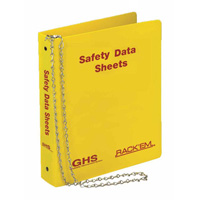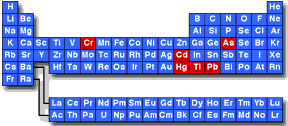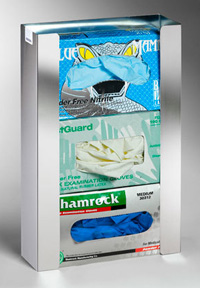



Find all of your laboratory and workplace safety supplies at Safety Emporium!
 HCC |
 Glossary Index |
 Hematuria |
| MSDS Topics |
Free Sites | FAQ's | Regulations | Glossary | Software | Suppliers |
| Books | Forum | Poll | Fun stuff | Quiz | Store | |
| Understand your MSDS with the MS-Demystifier | Search ALL our MSDS info | |||||

Get your SDS binders, centers and more from Safety Emporium.
The term heavy metal refers to any metallic chemical element that has a relatively high density and is toxic, highly toxic or poisonous at low concentrations. Examples of heavy metals include mercury (Hg), cadmium (Cd), arsenic (As), chromium (Cr), thallium (Tl), and lead (Pb).

"Heavy metal" also refers to a form of rock and roll music, but such references are unlikely to be found on Safety Data Sheets.
Heavy metals are dangerous because they tend to bioaccumulate. For example, marine organisms can consume a particularly dangerous form of mercury called methylmercury. When fish eat these organisms, the methylmercury is not excreted, but is instead retained in bodily tissues. The older the fish and the more contaminated organisms it has consumed, the greater the amount of methylmercury in its tissues. When another fish eats the first fish, the accumulated methylmercury is passed up the food chain, eventually becoming hundreds or thousands of times its original concentration. Any organism at the top of the food chain (humans, polar bears etc.) faces a serious risk of mercury poisoning by eating such fish.
 Here are multiple examples of heavy metal bioaccumulation that are threatening entire ecosystems.
Here are multiple examples of heavy metal bioaccumulation that are threatening entire ecosystems.
Lead poisoning is another example of heavy metal poisoning. Lead is neurotoxic, so individuals whose body is still developing (such as children or developing fetuses) are most at risk. While some aspects of lead poisoning are reversible in adults, in children this can interfere with normal development, cause irreparable brain damage, or kill.
Because of the recognized dangers of these elements, OSHA has established workplace guidelines for the following heavy metals:

Encourage your workers to wear their gloves with stylish safety dispensers from Safety Emporium.
Note: In 2014, researchers at the US National Institutes of Health discovered that mice exposed to low doses of arsenic in drinking water developed lung cancer at levels that are similar to possible human doses. It is a generally accepted principle that no level of arsenic exposure is safe. The US EPA has only recently phased out its use as an herbicide in most applications, although exceptions still apply for a few select industries, exceptions that should be ended.
Heavy metal exposure occurs through three primary routes:
If you are occupationally exposed to heavy metals, your workplace should have written protocols in place to minimize your exposure. A variety of controls such as eliminating or minimizing the use of such materials, the use of fume hoods, respirator requirements, medical monitoring and more may be required.
Presumably, employers should be taking care to ensure that no worker is exposed to potentially harmful levels of any substance. However, this is not always the case, so be vigilant. Be sure to read the Safety Data Sheets for any heavy-metal containing materials very closely. These should describe the symptoms of poisoning and chronic effects of exposure.
Heavy metals are fetotoxic, so women of child-bearing age should avoid any exposure to heavy metals. Note: the U.S. Supreme Court has declared it illegal under the Pregnancy Discrimination Act for employers to bar women from jobs that may expose them to lead or other toxins! See this OSHA Interpretation Letter on the ruling or this EEOC PDA fact sheet for more information.

Keep a record of your fire safety equipment inspections with these lightweight metal tags from Safety Emporium.
See also: alopecia, nephrotoxin, reproductive toxin.
Additional definitions from Google and OneLook.
Entry last updated: Saturday, December 31, 2022. This page is copyright 2000-2025 by ILPI. Unauthorized duplication or posting on other web sites is expressly prohibited. Send suggestions, comments, and new entry desires (include the URL if applicable) to us by email.
Disclaimer: The information contained herein is believed to be true and accurate, however ILPI makes no guarantees concerning the veracity of any statement. Use of any information on this page is at the reader's own risk. ILPI strongly encourages the reader to consult the appropriate local, state and federal agencies concerning the matters discussed herein.